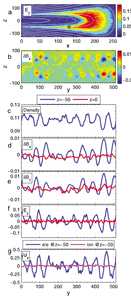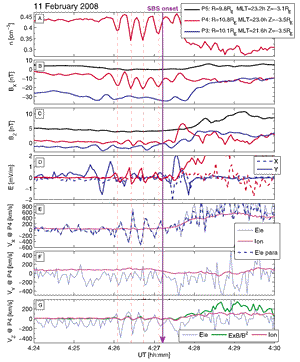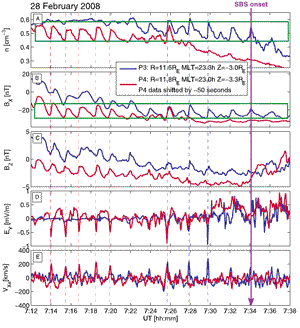
2012 THEMIS SCIENCE NUGGETS
Observations of kinetic ballooning/interchange instability
by E.V. Panov, Space Research Institute, Graz, Austria
Introduction
Ballooning/interchange processes have long been substorm onset instability candidates. As yet, however, there is no consensus about their physics, intensity, and significance for auroral breakup and reconnection onset. So far it has been difficult to identify ballooning perturbations using in situ observations during the turbulent dipolarization that accompanies breakup because of the complexity and mix of different perturbations during that time.
A configuration containing a tailward gradient of BZ and may be unstable to a kinetic ballooning/interchange instability (BICI), amongst others [Pritchett and Coroniti, 2010, hereinafter PC2010]. Such an instability may generate azimuthally-localized, dipolarization-like intrusions of underpopulated plasma tubes into the inner magnetosphere and may provoke reconnection onset [Pritchett and Coroniti, 2011].
The THEMIS [Angelopoulos, 2008] probes clustered at around 10-12 RE (P3, P4, P5) make it possible for us to directly investigate cross-tail size and propagation velocity. We also have collected more evidence of the kinetic nature of ballooning/interchange perturbations and discuss their consistency with BICI signatures.
| Figure 1. Results from PC2010 run: (a) (X, Z) cut of the Y-component of the electric field at Wt = 37.5 at y = 464. The white lines are magnetic field lines. (b) (Y, Z) cut of the X-component of the magnetic field oscillations, and Y-cuts of (c) the density, the (d) X- and (e) Z-components of the magnetic field oscillations, (f) the Y component of the electric field, (g) the X-component of the ion (magenta) and electron (blue) velocity at Wt = 37.5, and x = 130. |
Results
Figure 1 shows field and plasma parameters from the PC2010 particle-in-cell run simulating a kinetic ballooning/ interchange instability in a tail-like configuration. The electric field structure makes clear that the electron flow in the simulation is almost entirely field aligned, demonstrating that the BICI mode is a non-local mode in which significant kinetic ion and electron effects (bounce and drift resonant interactions) are present which are not included in an MHD treatment.
The perturbations are absent across the neutral sheet, so the mode at this cross-section is mostly confined to the off-equatorial part of the plasma sheet. The peaks above and below the neutral sheet either both increase or both decrease the field, revealing a sausage-like finger structure produced by the kinetic BICI. The perturbations produced by the BICI in BX and the other fields drift duskward at about one tenth of the ion thermal speed. Due to this drift the Y-profile of perturbations in Figure 1 is nearly equivalent to a temporal plot of parameters that would be observed by a magnetospheric spacecraft. Strong dBX (compressional) and dNe, together with phase-shifted dEY and dUXe, reveal distinctive BICI signatures in the cross-section near the BZ minimum, and the structure of BICI fingers cross-tail-drifting in the westward direction.
| Figure 2. Data from P3, P4, and P5 on 11 February 2008 between 4:24 and 4:30 UT: (a) electron density; (b, c) XGSM- and ZGSM-component of the magnetic field; (d) XGSM- and YGSM-components of the electric field; (e, f, g) XGSM-, YGSM-, and ZGSM-components of ion and electron velocity for P4). SBS stands for substorm. See legends for color coding. |
Figure 2 shows THEMIS probe (P3, P4, and P5) observations on 11 February 2008 between 4:24 and 4:30 UT. The probes were clustered at radial distances between 9.8 and 10.8 RE downtail. The probes were located within 1 hour MLT eastward of the auroral breakup arc.
This substorm onset followed 2 min-long strong field and plasma oscillations (period about 20 seconds) observed
by P3 and P4 after 04:25:30 UT. Figure 2b shows that the oscillations’ amplitudes in the XGSM magnetic field component reached 20 nT at P4. P4 was located between P3, which was in the plasma sheet boundary layer, and P5, which was in the central plasma sheet. It is interesting that the oscillations at P5 (i.e., in the neutral sheet) did not exceed 2 nT. This suggests that the current sheet oscillations could be sausage-like (i.e., balloons) rather than flap-like structures (i.e., kinks). The BX-oscillations were accompanied by phase-shifted electric field oscillations with the major EY -component (Figure 2d), such that EY ~∂BX/∂t.
The intense BX and EY oscillations are typical of the kinetic BICI suggested in PC2010. Another signature of this instability is the oscillating XGSM electron velocity component unaccompanied by corresponding ion velocity oscillations (see Figure 2e). The electron velocity oscillations were in phase with the oscillations in EY. The strong peaks in electron VX with amplitudes comparable to VTi are another essential signature of kinetic BICI (PC2010).
| Figure 3. Data from P3, P4, and P5 on 11 February 2008 between 4:24 and 4:30 UT: (a) electron density; (b, c) XGSM- and ZGSM-component of the magnetic field; (d) XGSM- and YGSM-components of the electric field; (e, f, g) XGSM-, YGSM-, and ZGSM-components of ion and electron velocity for P4). SBS stands for substorm. See legends for color coding. |
Figure 3 presents a much longer oscillation event on 28 February 2008 between 7:12 and 7:38 UT (the oscillations
started at about 7:00 UT, not shown here). The observations at P4 (red line) were shifted in time by 50 seconds to highlight the similarity of curves at P3 and P4. Figures 3a and 3b show anti-correlated oscillations of the electron density and the XGSM magnetic field component with a period of _100 seconds observed by P3 and P4. Figures 3c–3e show nearly the same BICI signatures as the observations in Figure 2: smaller-amplitude oscillations in BZ and large oscillations in EY (Figures 3c and 3d). Figure 3e also shows similar oscillations in the XGSM-component of the electron velocity, without comparable ion velocity oscillations (for better visibility we do not show the ion velocity).
In this event P3 and P4 were separated by 5950 km mostly along the YGSM-axis. Long-lasting oscillations allowed us to compute the cross-correlation of the signals from P3 and P4, which gave a distinct peak at 50 seconds and indicated duskward propagation at a velocity of about 120 km/s. The characteristic cross-tail scale for the half-period of T = 50 seconds is then 6000 km.
Conclusion
We show THEMIS observations of field and plasma oscillations at 11 RE prior to breakup. Detailed comparison of these observations with the PIC simulation run from PC2010 suggests that the oscillations grew during development of a kinetic ballooning/interchange instability. In particular, we find agreement regarding the strong dominance of the electron VX oscillations over the ion velocity oscillations; the general sausage character of the mode perturbations; and the frequency, wavelength, and duskward velocity drift of the oscillations. The oscillations drifted duskward at about 120 km/s, and their wavelengths were about nine to twelve thousand km, comparable to a gyroradius of 10 keV ion in B~2 nT.
References
Panov, E. V., V. A.Sergeev, P. L. Pritchett, F. V. Coroniti, R. Nakamura,W. Baumjohann,V. Angelopoulos, H. U. Auster, and J. P. McFadden (2012), Observationsof kinetic ballooning/interchange instability signatures inthe magnetotail, Geophys. Res. Lett., 39, L08110, doi:10.1029/2012GL051668.Angelopoulos, V. (2008), The THEMIS Mission, Space Sci. Rev., 141, 5–34, doi:10.1007/s11214-008-9336-1.
Pritchett, P. L., and F. V. Coroniti (2010), A kinetic ballooning/interchange instability in the magnetotail, J. Geophys. Res., 115, A06301, doi:10.1029/2009JA014752.
Pritchett, P. L., and F. V. Coroniti (2011), Plasma sheet disruption by interchange-generated flow intrusions, Geophys. Res. Lett., 38, L10102, doi:10.1029/2011GL047527.
Biographical Note
E.V. Panov is a research fellow at the Space Research Institute, Austrian Academy of Sciences, Graz, Austria. His current research activities are focused on BBFs’ oscillatory braking and ballooning waves in the near-Earth plasma sheet.
 Please send comments/suggestions to
Emmanuel Masongsong / emasongsong @ igpp.ucla.edu
Please send comments/suggestions to
Emmanuel Masongsong / emasongsong @ igpp.ucla.edu


